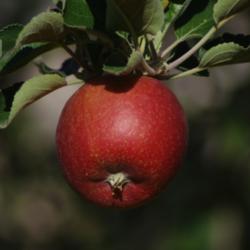
Water young trees regularly, especially those on semidwarfing or dwarfing rootstocks, to ensure that the root system becomes well established. Renew mulch periodically, but pull it away from the tree in the fall so mice don't nest over the winter and eat the bark.
Training Young TreesTrain dwarf apple trees to the central leader system. In the early years of growth, it's important to create a strong framework of scaffold branches because apples can bear heavy crops year after year. Semidwarfing trees can be trained to a central leader shape, but are more easily trained to a modified leader system. Standard trees should also be trained to a modified leader. Prune bearing trees annually. Larger trees need more pruning and you'll eventually have to use a ladder to get the job done. Spur-type apples require less pruning than other trees because they produce more fruiting spurs and less vegetative growth. Apples are often grown without any thinning other than what nature provides in the annual spring drop. However, to avoid potential disease and insect problems, you might want to thin after the natural fruit drop (about 4 to 6 weeks after bloom) to one fruit per cluster, or about 6 to 8 inches between fruit.
Potent PestsHome gardeners who wouldn't dream of using pesticides on other crops may have to consider this option with apples. The fruit are subject to many insect and disease attacks that twist, perforate, and mangle them; most caretakers must spray to get an acceptable crop. But there are alternatives. You can avoid using fungicides by selecting disease-resistant varieties such as 'Prima', 'Priscilla', 'Liberty', and 'Freedom'. These have been field tested for many years and require no spraying for apple scab, cedar-apple rust, and other common diseases, while most other varieties require periodic spraying every spring and summer after planting.
Apple maggots, plum curculios, green fruitworms, and codling moths are pests that can trouble a crop. Annual spray programs are usually necessary. Check with your extension service to find approved pest prevention programs for your area. Other pests such as scales, mites, and aphids should be controlled by natural parasite and predator populations if you haven't used a lot of sprays. For problem areas, you can try an anti-insect oil, usually available where pesticides are sold. Spray it in the spring when your apple trees are in the tight cluster stage: after the leaves have unfolded from the fruiting cluster, but before the buds begin to show pink.
HarvestingMost apples are ready to pick when they separate easily from the tree. With some varieties, you may notice the fruit softening a bit or apples may start dropping. Another indicator is the color of seeds in the core -- when they turn dark brown, the apples are ready. Don't yank on the apple to pick it; instead, twist the fruit upward with a rotating motion. Early-season apples tend to start bearing at a younger age; but they generally don't keep long after harvesting them. Many late-season types have good keeping qualities -- they'll keep for a few weeks in a cool place. In a good root cellar, storage apples can keep 5 months or so.
 Victory Seed Company has all the seeds you want for your best garden in 2024.
Victory Seed Company has all the seeds you want for your best garden in 2024.
For 25 years, the family-owned Victory Seed Company has provided the highest quality vegetable, herb and flower seeds to families across the country. We are passionate about providing you the best seeds available that give excellent germination, robust plants, and the harvest you want. With a catalog of over a thousand varieties, we have everything, and our prices are the kinds that we'd want to pay. We have hundreds of yesterday's heirloom vegetables, as well as today's award winning hybrid selections. Get to know us by visiting our website and browsing through our online vegetable seed catalog.
| 1. Apple Essentials |
| 2. Planting Apple Trees |
| 3. Choosing Apple Varieties |
| 4. Apple Tree Care ← you're on this article right now |
| 1. Apple Essentials |
| 2. Planting Apple Trees |
| 3. Choosing Apple Varieties |
| 4. Apple Tree Care ← you're on this article right now |